 |
|
 |
|
|
If your browser labels this site "Not Secure," don't worry. You are not typing personal
information here, so security is not needed. Click here
for more explanation.
|
|
2018
December
31
|
Melody and rhythm, episode 2
Friday, December 28, the day that began with the predawn furniture
delivery, also ended in an unexpected way.
Melody got an upset stomach during the afternoon, and it upset her
heart rhythm. So around 10 p.m. I took her to the emergency department
of Piedmont Athens Regional, and this morning, December 31, she had
catheter ablation of both atria for atrial flutter. She will come home
tomorrow. She is feeling much better already.
We have seen the new year in every year since 1977, but this time we
celebrated it according to Greenwich Mean Time, as we also had done in 2017,
because I couldn't be with her at local midnight. So, for me, it's already 2019
(what an inflated-looking number!).
I had dinner and, to celebrate Melody's recovery and the new year, I treated myself
to a Good Humor King Cone for dessert. Fifty-seven years ago, when I was four years
old and living in Columbus (Ga.), an ice cream truck came by and I chose a King Cone,
I think mainly because I could read both words of its name. Tonight I chose it because
I liked it, and my diet allows me one about every ten years.
Permanent link to this entry


|
2018
December
29
|
Home Depot's pre-dawn furniture delivery
December 28 began strangely, with the telephone ringing at 6 a.m.
They're lucky I answered it, because (to foil robocallers) the telephones
don't ring in our bedroom; they only light up.
Nonetheless I happened to be awakened by the light.
It was a delivery driver for Home Depot, and at 6:30 a.m.,
in the dark and in the rain, they brought a
piece of furniture that Sharon had ordered.
It was an unassembled TV stand, in two boxes, and they could have brought it
in the smallest of pickup trucks, or even a station wagon.
But they brought it on a 10-wheeler flatbed truck with a forklift attached
to the back of its trailer.
It was the only thing on the truck.
The driver pulled up in front of the house, undocked the forklift, and used it to
bring the two boxes up the driveway, beeping loudly all the way.
Then he carried it into the house.
And that was how Home Depot delivers furniture to a residence (and wakes up the
neighborhood).
The back story is even stranger. The delivery had been scheduled for a few
days ago, and we got a call that they couldn't make it because the driver had
gotten a ticket for trying to bring a truck into a residential neighborhood.
(Timothy Road is indeed "no trucks," but local deliveries are an exception.)
So we expected a smaller truck this time. No; just a more determined driver.
Permanent link to this entry


|
2018
December
26
|
Christmas came

We had a low-energy Christmas (all suffering from bad colds) but a good one.
Melody made the traditional lasagna, and then we exchanged presents around the
dinner table, with a rosemary plant doing service as the Christmas tree.
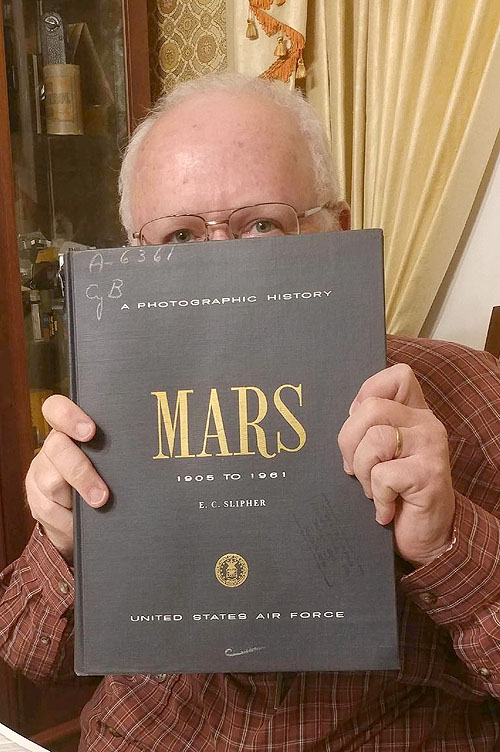
Melody gave me a historic astronomy book, E. C. Slipher's book of Mars photographs
published by Lowell Observatory with the assistance of the Air Force Cambridge Research
Laboratory. This isn't just any copy of it — it's one that was in the library
of the Air Force Cambridge Research Laboratory itself, and the tipped-in photographic print
is perfectly intact.
This book is the culmination of Lowell's and his successors' work on Mars, based on the
theory that there are "canals" (narrow streaks) crisscrossing its surface.
The photographs are remarkably good for the time (no digital image processing) and are
almost as good as I now get with my 8-inch telescope.
They are at just the right resolution to support the "canals" — if they were
appreciably sharper, we would see (as we did see from space probes in the late 1960s)
that Antoniadi was right, there are no "canals," there are just irregular spots that seem
to join up when blurred together.
Permanent link to this entry
AR-1
Sharon gave me something much more récherché — an electronic component that was on my wish
list 50 years ago, and which I never managed to get. It's a General Electric AR-1 light bulb;
it makes light by passing electricity through low pressure argon gas rather than by heating up a
filament.

At the time, the AR-1 was marketed as a cheap source of weak ultraviolet light and as an
indicator lamp or night light. It had a neon counterpart, the NE-34, which I had, and which
glowed orange. The positively charged electrode glows; operating on alternating current, the
two electrodes actually alternate glowing. The required current is small, and the lamp can be
controlled easily by a vacuum tube or thyratron, hence its use as an indicator.
Its rated life is actually not any longer than a conventional light bulb, so it wasn't a very
good night light, and I never saw it used as such.
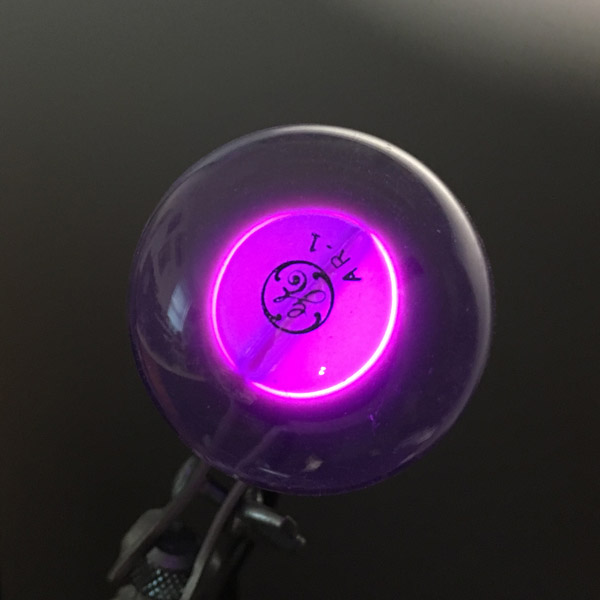
I'll use this as a display piece.
With a diode, resistor, and capacitor, or a more complex circuit, it can be
made to blink on and off. Curiously, it arrived with the electrodes slightly bent out of place
and shorted together; fortunately I noticed, and by just banging it around a bit (gently!) I was able
to get them to separate. They are bent down at the outside but should be flat (in the same plane, like
a flat disk with a slot in it). Now to find an NE-34 and make some kind of gadget to display them both...
Permanent link to this entry


|
2018
December
25
|
Feast day of the Nativity of Our Lord
My soul proclaims the greatness of the Lord,
and my spirit has rejoiced in God my Saviour,
for He has looked upon the lowly estate of his servant.
Behold, from now on every generation will call me blessed,
for the Mighty One has done great things for me,
and holy is His name.
Song of Mary (Luke 1:46-49)
my translation
Permanent link to this entry


|
2018
December
24
|
The Christmas comet
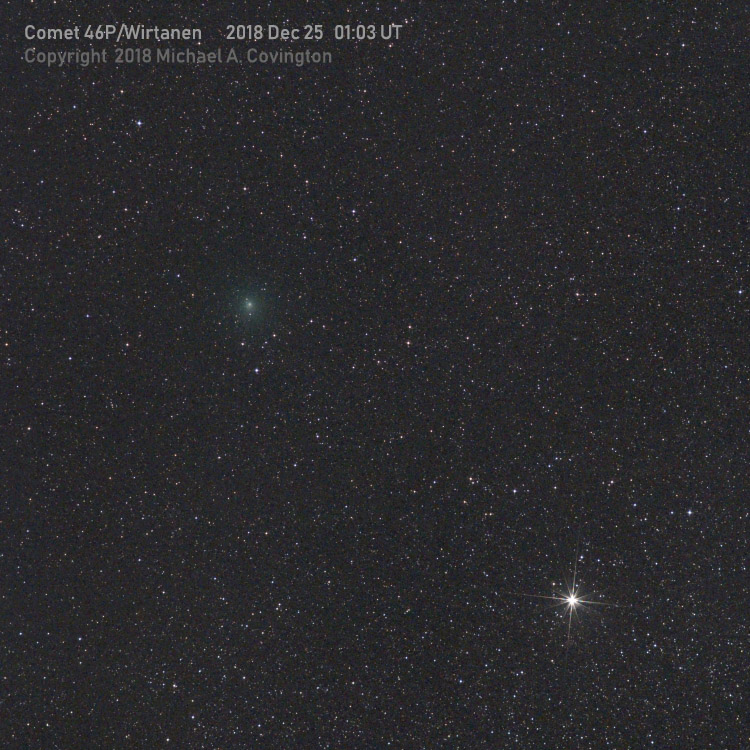
Yes, we have a comet in the sky on Christmas night.
It's probably visible to the unaided eye if you are out in the country;
in town, I saw it with 10x42 binoculars.
It's north and a bit east of the star Capella, the conspicuous bright star in the northeast.
I photographed it about an hour ago, before the moon rose, making it
harder to see. Single 56-second exposure, Canon 60Da at ISO 800, Sigma 105-mm lens at f/4.
Permanent link to this entry


|
2018
December
24
|
A small blue planet

NASA
Do you remember Christmas 1968? I remember vividly being at my grandparents' house
and spending time with cousins, and following the progress of Apollo 8, which orbited
the moon but did not land on it.
Although personally we were doing OK, it had been a
terrible year for the United States,
with bitter division over the Vietnam War and other issues.
Martin Luther King and Robert F. Kennedy had been assassinated — two in
one year.
There were race riots, and an overt racist ran for President and placed third.
But many of us were looking to the future and to outer space.
The movie 2001: A Space Odyssey came out that year; different people got different things
out of it, but the most important is awareness of our small place in a big universe.
Star Trek was by far the best thing on television.
And at the end of the year, Apollo 8 gave us the picture reproduced above,
the picture that, for many citizens of many countries, signaled an opportunity
to step back and look at our small blue planet as a whole, and wish for unity and peace.
Unlike many, I don't find Star Trek or 2001 or technological optimism
or scientific discovery to be a sufficient philosophy of life.
So I was especially glad that the astronauts read Bible verses in a spirit of thanking
God for His creation.
We wish all our fellow inhabitants of this small blue planet a blessed Christmas and a
successful and prosperous New Year.
Permanent link to this entry
Christmas links
Astronomy and the Star of Bethlehem (follow a chain of links from here)
Santa Claus and St. Nicholas
What is Christmas, and is it under attack?
Permanent link to this entry


|
2018
December
23
|
H$liday
$hopping
$ea$on
More than any time I can remember in recent decades, our town is
having a full-on 1960s-style "Christmas Rush" making it, at times,
almost impossible to get into stores or shopping districts.
I'm thankful for the prosperity that must be resulting from it, but at the same time a bit
inconvenienced; I'm doing a few things other than "Holiday Shopping" and don't want
to have to stop in my tracks!
Melody, Sharon, and I are aiming for a low-key Christmas. Melody and I have bad colds; we all feel the need to
slow down and rest; family members are far away; consulting business is booming and I don't want to be
away from it more than a couple of days; so we're going to have a good Christmas but not an
elaborate one. Our main presents to each other for the past several weeks have been improvements to the
house and yard: major yard work; pressure washing and painting the outside; and converting Cathy's old bedroom into a
second room for Sharon. So you may not see a lot of decorations here, but we are enjoying being together.
Speaking of shopping, yesterday I was in a major chain Christian bookstore for the first time in a while and was
pleased to find it operating on a higher intellectual level than formerly. There wasn't much shallow entertainment.
Theology and apologetics were prominent. Churches are finally starting to realize that college-educated people
need more than "Bible stories" or "experiential" religion; systematic theology isn't just for pastors; anybody smart
enough to know what a logarithm is should also know what is meant by (for example) Pelagianism.
I was a little disconcerted that "Women's Bible Study" is such a big genre. I'm glad women study the Bible but wonder
why their books have to be tagged "for women" as if they couldn't just do plain Bible Study.
(Marketing, like "software for girls" in pink boxes?)
But the only thing in the store that really struck me as incongruous
was a Bible illustrated by Thomas Kinkade. I didn't open it up and look inside.
Permanent link to this entry
Comet and Capella in moonlight
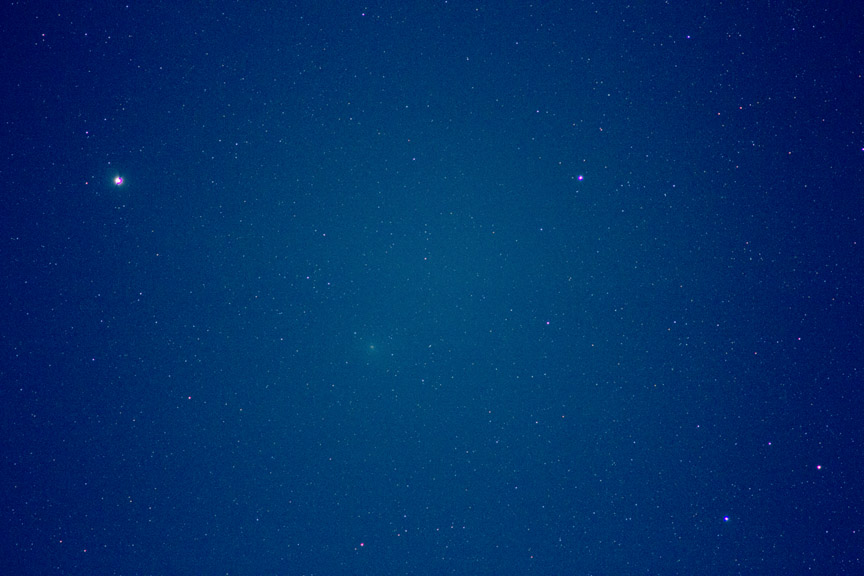
Last night Comet Wirtanen was close to the star Capella in Auriga, but the full moon was high
in the sky, quite close to it.
Here is a single 10-second exposure with a Canon 60Da and Zuiko 200-mm f/5 lens
on my iOptron SkyTracker. The three stars other than the brightest one are a group called
"the kids," Capella being mythologically a goat.
Permanent link to this entry
Hint for polar scope users
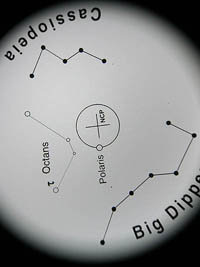
I recently figured out why my polar alignment scope wasn't helping me align my AVX to the
earth's axis as accurately as it should.
It turned out that, looking into the eyepiece with my head tilted, I was having trouble
judging which way was up. I was systematically about 30 degrees off, which meant that at
this time of year, Polaris was ending up about 20 arc-minutes to the left of where it ought to be.
And I found a simple cure. Use the altitude knob to see which direction is up.
Center Polaris, then use the altitude knob to move it straight down (it has to be straight
down if you don't touch the azimuth knobs), and go from there.
Permanent link to this entry
Solid-state disk comes to Covington Innovations

Finally I'm entering the 21st Century, with solid state disk (SSD) storage in one of my computers
(the small laptop I use for telescope control). I'll convert the main laptop and desktop soon.
Here you see the original Hitachi disk drive being "cloned" onto an SSD drive. The Sandisk drive here
is not a rotating magnetic disk; it uses integrated circuits just like a flash memory card or thumb drive.
But, electrically, it is a plug-in replacement for the disk drive. The contents of the drive are being copied by a Kingwin
disk-copying device; no computer is involved; the cable is only for power.
The operation was a success. The laptop now boots much faster (important because I alternately boot
Windows and Linux on it) and other software packages load faster. I haven't tested performance in any
detail yet.
Permanent link to this entry


|
2018
December
17
|
Comet, meteor, and star cluster
Others, especially those who could wait for the moon to set, have gotten much better
pictures of Comet Wirtanen passing near the Pleiades, but I didn't come away empty-handed;
in fact my picture also includes a meteor.
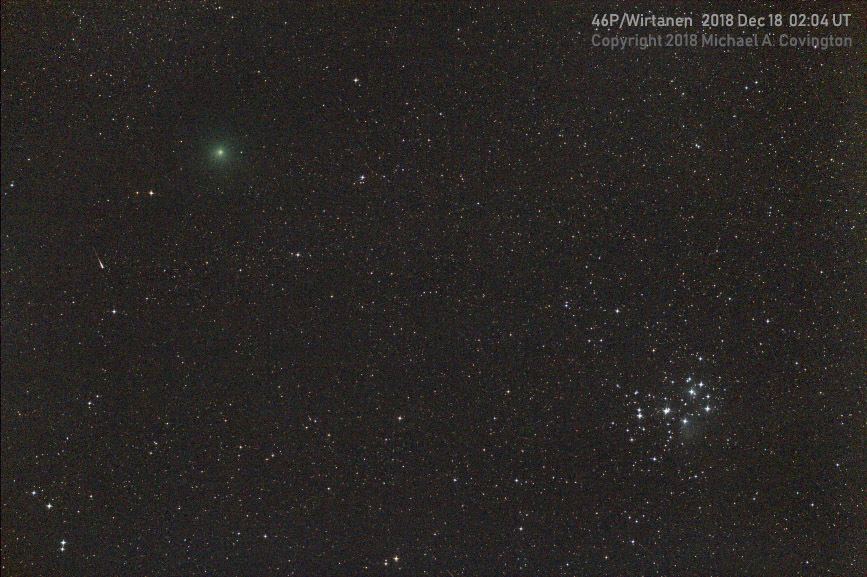
Single 30-second exposure, Canon 60Da, Sigma 105/2.8 lens at f/4, AVX mount.
Permanent link to this entry


|
2018
December
16
|
Comet Wirtanen
Tonight (Dec. 16), Comet Wirtanen is making its closest pass to earth, and other people
are getting beautiful pictures of it next to the Pleiades star cluster.
Not, however, me. We have thin, high clouds, and the moon is high in the sky.
The moon is far enough away from the comet that some people are going to get to wait
until after moonset; they will get much better pictures.
I, however, am going to show you pictures I got in a clear, moonless sky on December 11
(12th Greenwich Mean Time). This is a stack of twenty 1-minute exposures with an AT65EDQ refractor
(6.5 cm f/6.5) and Nikon D5300 camera. They are aligned on the comet, which was moving, so the
stars are streaks, and faint ones at that.
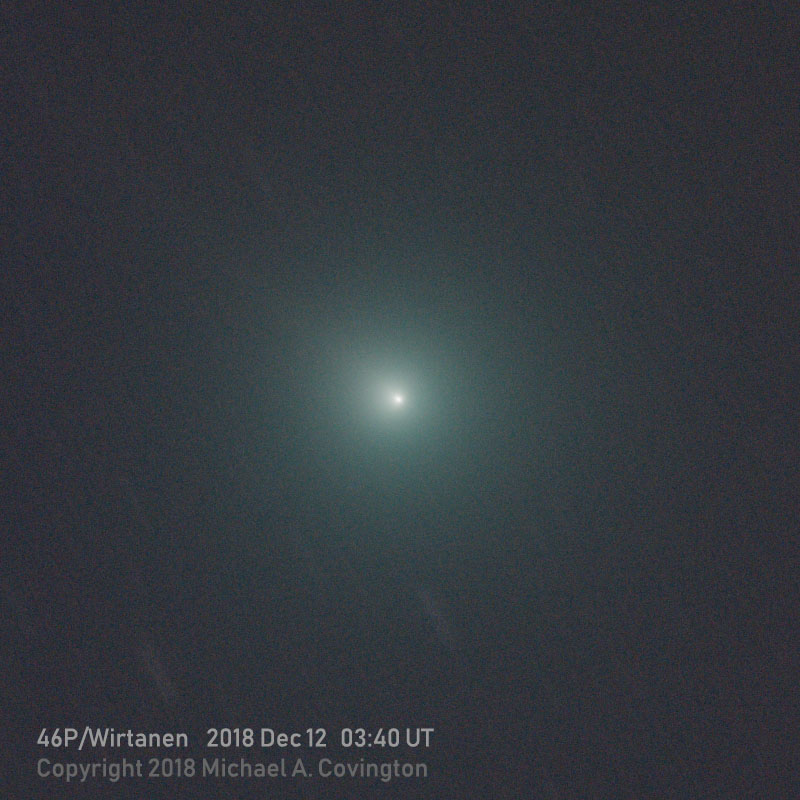
This picture conveys what a comet is — a rocky, icy core that emits gas in all directions
when it gets close enough to the sun to melt the ice.
Of course, the spot in the center is not the core itself, but rather the dense middle of the
gas cloud.
The asymmetrical effect of the solar wind causes most comets to grow tails by driving gas away
in a specific direction, away from the sun.
This comet doesn't have much of a tail.
This reinforces the fact that it is a small comet that happens to be rather near us
(still 30 times as far as the moon), not a large comet with a tail extending millions of miles.
But there is a tail.
Here you see the same picture as above, reduced, and then a copy of it processed with much
higher contrast. There are streaks representing the trailed images of stars, and there is indeed
a tail pointing to the upper left.

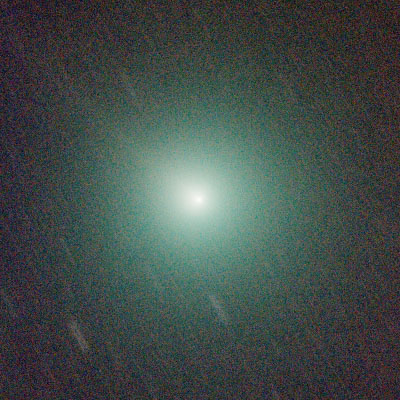
Permanent link to this entry
The Crab Nebula at low magnification
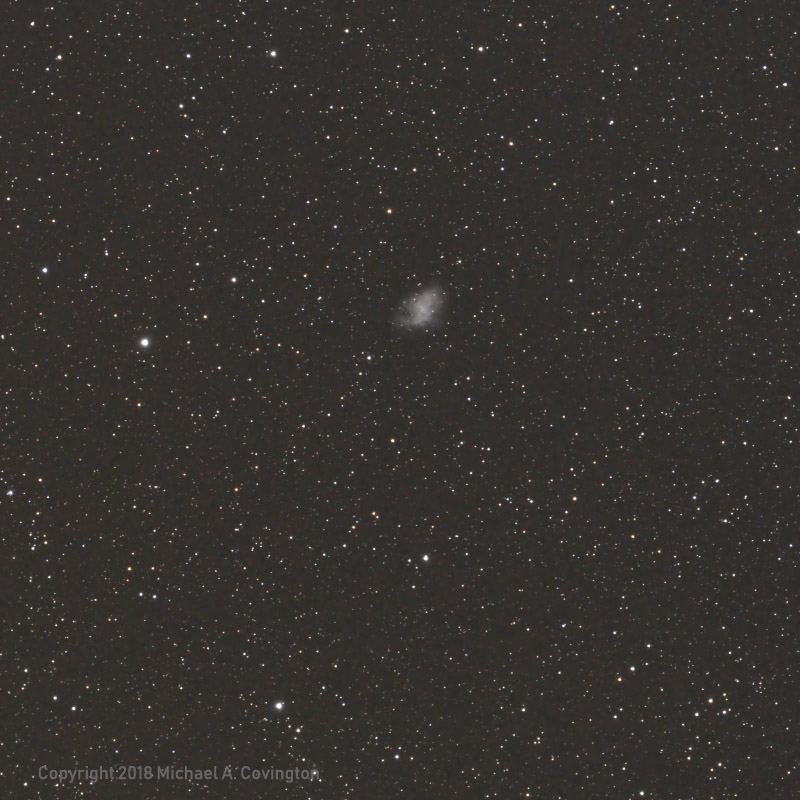
This low-magnification image gives a good impression of how the Crab Nebula (M1) looks in a
small telescope, except that it's not as bright in real life as in the picture.
It was discovered in the 1700s by John Bevis, and at the time it must have been brighter
than now, because it was only 3/4 of its present age and hence was more compact.
It is the remnant of a supernova that was seen in the year 1054 A.D.
Of course, it really happened long before 1054 A.D., but the point is, the delay affected
its entire history the same way, so as seen from earth,
it really looked only 3/4 as old in the 1700s as today.
Permanent link to this entry
Rosette
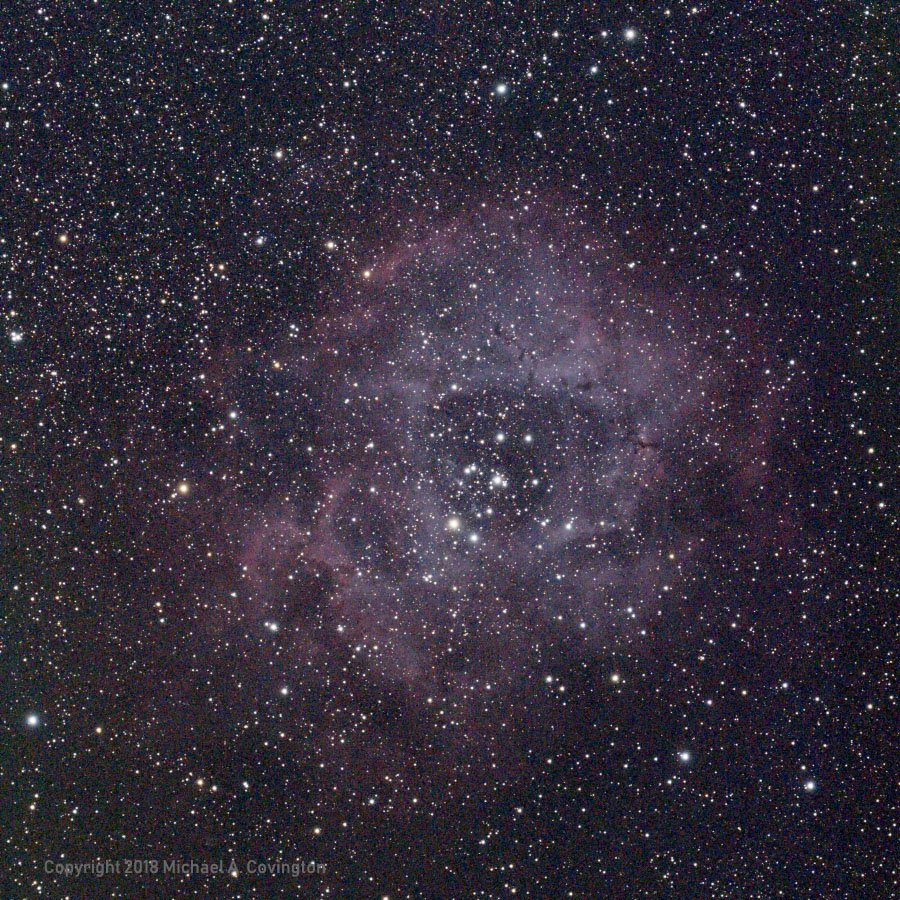
The Rosette Nebula, which surrounds the star cluster NGC 2244, is almost invisible with
a telescope; we have to rely on the camera to accumulate light.
Even so, photographing it in town (in a sky brightened by city lights) with an unmodified DSLR
(not sensitive to hydrogen-alpha) is a challenge. This is a stack of seventeen 1-minute
exposures with the same AT65EDQ refractor and Nikon D5300 camera as the other pictures
I've posted here recently.
Permanent link to this entry


|
2018
December
13
|
How I responded to the Russian e-mailed bomb threat
[Updated.]
Like many Americans, I received an e-mailed bomb threat today.
I was apparently one of the first, receiving it at 12:45 EST.
I did some quick investigating and shared my results with the local police,
who got another report of it from elsewhere in town right afterward.
I hope I was able to help by giving them some analysis.
Here's what I did and how you can protect yourself in similar situations in the future.
Looking at the message, I asked myself the key questions about suspicious e-mail:
(0) Does it ask me to click on anything (link, file, URL, etc.)? If so, DON'T!
In this case the message contained nothing to click on.
But malicious e-mails often do, and it important not to click on
anything in them, because when you do, you're sending your computer to
a malicious web site or executing a malicious piece of software.
(1) Do they really know who I am and where I am?
Apparently not; they worded it as if I were in an office building open to the public. I am not.
They called it "your building" and showed no knowledge of any specific place.
Remember, "we know where you live" is not true just because someone says it!
(2) Could they be sending the same threatening message to a lot of people?
Definitely, yes. It contained nothing specific to me.
(3) From the criminal's point of view, does the crime make sense? Could it work?
Here, also, I saw problems.
They didn't know if the e-mail even reached me.
Some people are out of town or don't check their e-mail often.
Some e-mail gets lost in transit or eaten by spam filters.
The threatening message could — but did not — include a return receipt request,
to make my mailreader tell theirs that I had opened it and seen it.
Would they blow up buildings without knowing whether anyone in them even got the
threat in the first place?
And if I paid the ransom, would the bomber really come and remove the bomb (and get
caught)? What incentive would he have to really do it? How would he prove he had done it?
The proper response to a credible bomb threat is to call the local bomb squad, not pay a large
amount of money to a complete stranger.
Another way in which the crime would not work is that they can't keep victims from hearing from
each other. Within minutes of the mass mailing, some of us knew it was a mass mailing.
And we're not going to believe that someone would plant hundreds of bombs all over the
country, with the same threat attached to all of them. One bomb might be real; a hundred bombs
certainly are not.
Granted, there is no limit to how dumb criminals can be, so this is not conclusive by itself.
But it did weigh with other considerations to tell me that the message was probably a hoax,
designed to create panic and cost,
or possibly a dodge to draw attention and police away from a real crime other than what it
described.
(4) Are they pretending to be someone else?
Not really relevant because they weren't pretending to be anyone specific to being with,
but if e-mail ever claims to be from any kind of authority (FBI, IRS, bank, or company),
this is the question you should ask. See also:
warning signs of fake e-mail.
Investigation:
After sizing up the threat, the next thing I did was
analyze the header
and then do a traceroute to find out
the path to the site the message came from.
In fact, the header was short and simple — they usually are, nowadays — and the
site was quite clearly in Russia (unless there was another level of fakery, which seems possible,
but not consistent with the overall style). If they had claimed to be from somewhere recognizable,
then I'd suspect more fakery, but they didn't.
With all those things in mind, after a brief
consultation with the police, I decided not to evacuate the place
or even have it searched for bombs. I knew that nobody could have gotten in to plant anything;
it is not a public place.
And sure enough, nothing has blown up.
One last thought. I think we need to look closely at Bitcoin because it provides a completely
private, secure way for people to pay ransoms, and thus creates new risks.
I predict that things like this will lead to heavy legal restrictions on Bitcoin.
Permanent link to this entry


|
2018
December
10
|
Comet 46P/Wirtanen
The brightest comet in several years is currently in the evening sky just west of southern Orion.
See this map if you want to look for it.
It will be brightest December 16, but the moon will then be high in the sky,
so it's probably better to look for it as soon as you can.
It's faintly visible to the unaided eye in a dark country sky;
in town, I need binoculars to see it.
The following two pictures are each a stack of twenty 1-minute exposures through an AT65EDQ
6.5-cm f/6.5 refractor. The stack is aligned on the comet, which is moving, so the stars are
faint, blurry streaks. You can see that the comet is developing a short tail, which points to the
upper left (northeast).
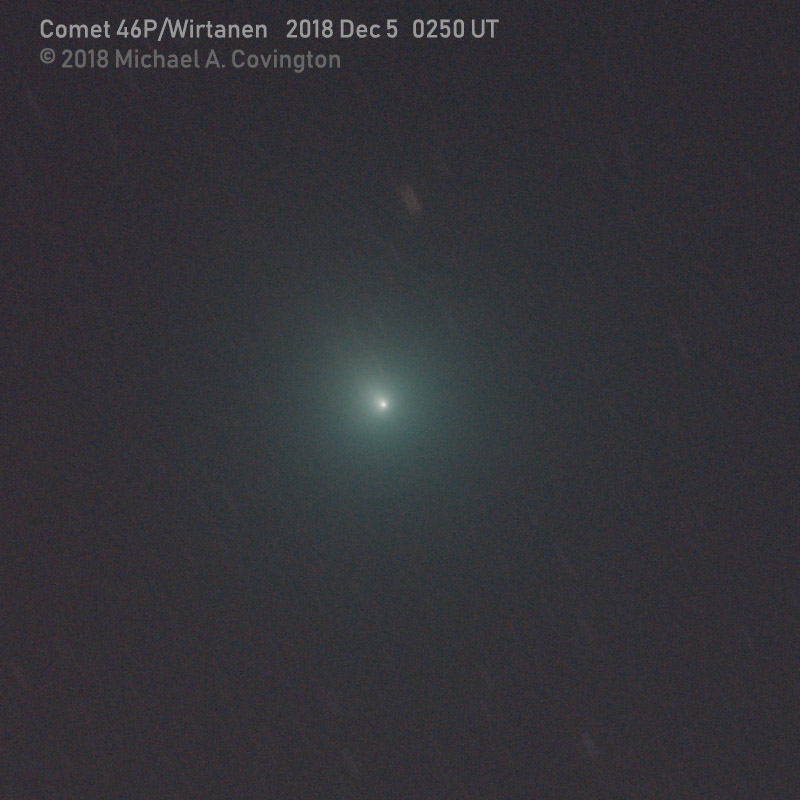
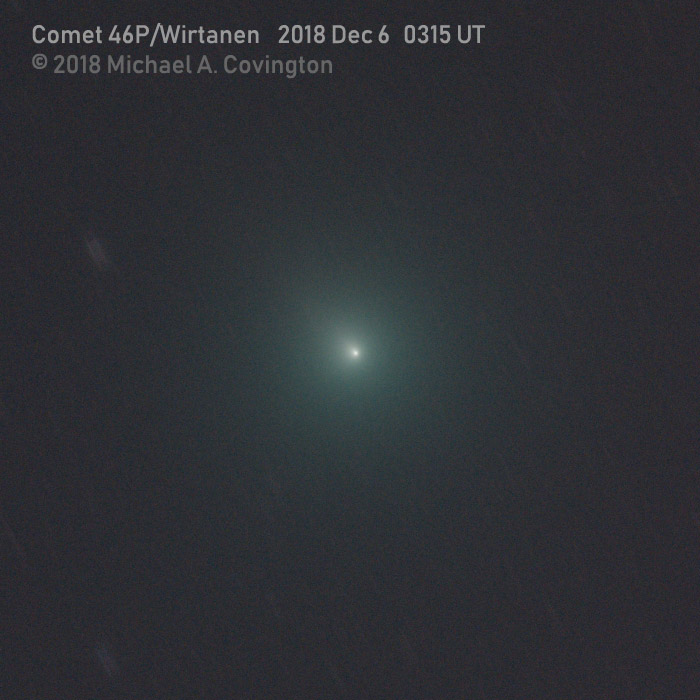
I haven't tried to calibrate the scale of these pictures, but the comet covers about the
same area of sky as the full moon. It is of course much larger and farther away.
Like all comets, it consists of a rocky or icy core and a large shroud of gas
released by the core as the sun warms it.
Permanent link to this entry
Galaxy NGC 253

On the evening of December 4 (December 5 UT), I also grabbed this image of the galaxy NGC 253
in the constellation Sculptor, which was rather low in the sky.
I need to come back and photograph it with my 8-inch.
Notice the amount of detail that the 6.5-cm (2.6-inch) telescope captured.
Like several recent pictures, this is a stack of twenty 1-minute exposures
with an AT65EDQ and Nikon D5300.
Permanent link to this entry
The nebula that still isn't there
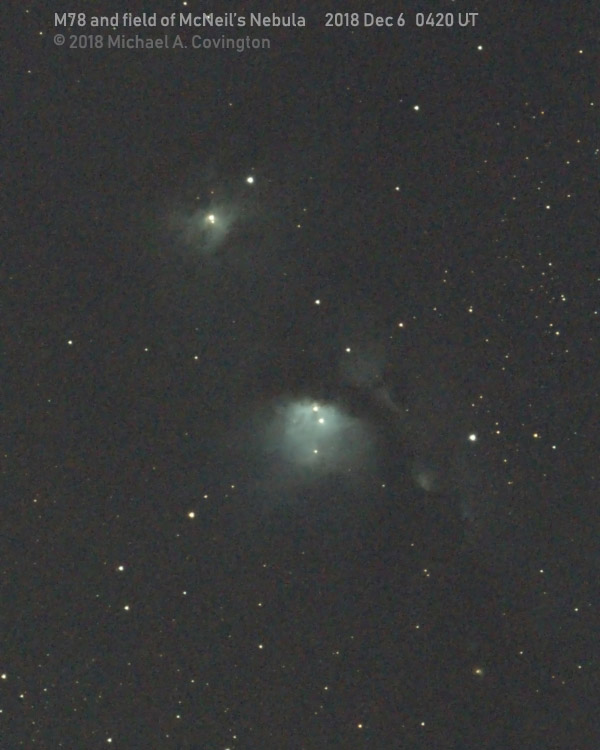
This is a picture of the field of the nebula M78, very similar to the one I took
on December 2 (December 3 UT; scroll down for it). You can see other nebulae,
especially a bright one to the upper left, but also some wisps to the lower right
of M78. What you can't see is McNeil's Variable Nebula, which has faded
from view. It should be just to the right of the double star that is to the
lower right of M78. Other wisps are visible that are comparable to the normal
brightness of McNeil's, but McNeil's itself isn't there.
Permanent link to this entry
Pleiades!
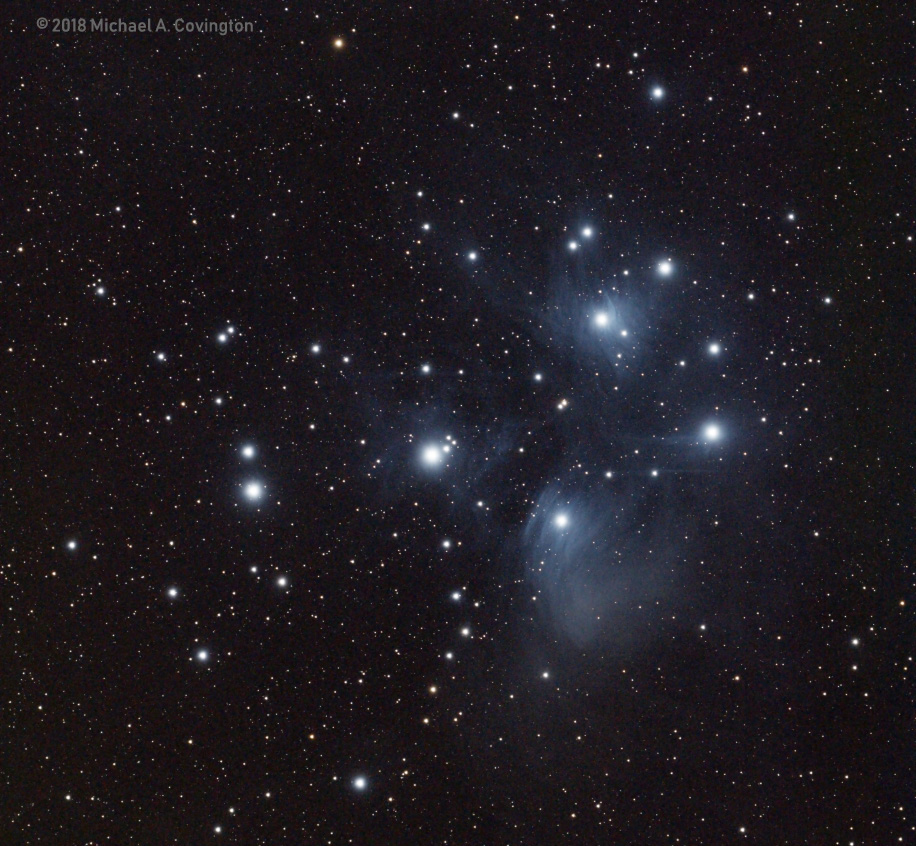
The Pleiades, a prominent star cluster in Taurus easily visible to the naked eye,
are embedded in interstellar dust, which aligns in long streaks because of the
stars' magnetic fields. This is one of my best pictures of the Pleiades ever.
Stack of twenty 1-minute exposures, AT65EDQ 6.5-cm f/6.5 refractor, Nikon D5300
at ISO 200, AVX mount, PEC, no guiding corrections.
Apart from being a beautiful and astrophysically interesting picture, this is also
confirmation that the AT65EDQ is free of internal reflections. That means it is suitable
for photographing faint objects near bright stars, and also total solar eclipses,
which involve faint corona and bright corona in the same picture.
Permanent link to this entry


|
2018
December
9
|
Orion Nebula in HDR

Unlike the astrophotos below, this one is just a pretty picture. The Orion Nebula is one of the
easiest celestial objects to photograph well, and I've photographed it many times.
This one is a stack of twenty 1-minute exposures through an AT65EDQ 6.5-cm f/6.5 refractor
and a Nikon D5300 at ISO 200. Taking advantage of the camera's large dynamic range, I used
the HDR processing tool in PixInsight to preserve detail in areas that would otherwise have
been overexposed.
Heavy-handed HDR is overused in astrophotography, and I was hesitant to use it.
But PixInsight's tool is not heavy-handed, and in this case it brought out genuine
detail in the image.
Permanent link to this entry
M77 with no supernova
Now for some real astronomy — some pictures that reveal recent changes
in distant parts of the universe.
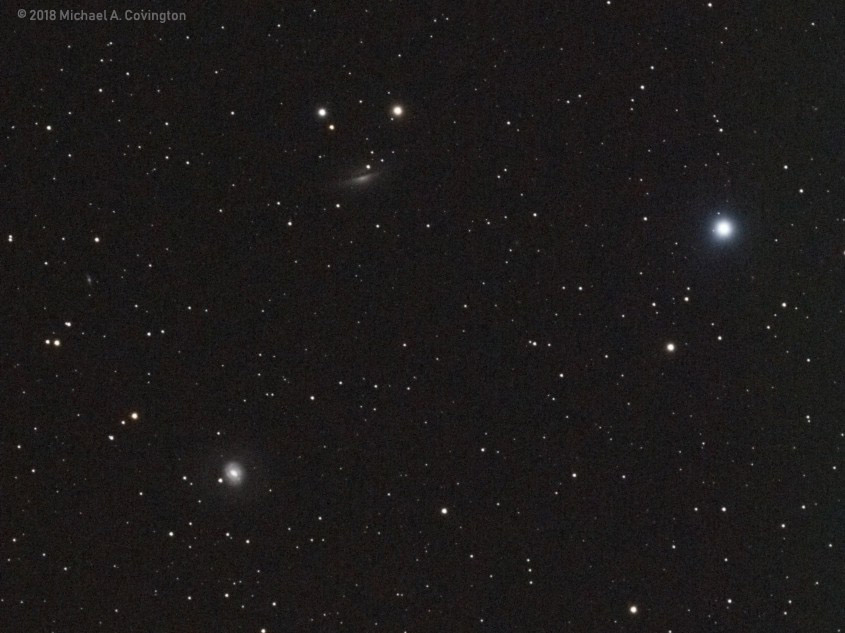

The first picture shows the galaxy M77 (bright and round), the edge-on galaxy NGC 1055,
and the star Delta Ceti. The second is an enlarged and brightened area of the same picture,
showing that the supernova recently reported in M77 is not there — it must be fainter
than 17th or 18th magnitude now. The stars visible superimposed on the galaxy in this picture
are the ones that have been there a long time; they are in the foreground.
Stack of twenty 1-minute exposures, AT65EDQ 6.5-cm f/6.5 refractor, Nikon D5300 at ISO 200.
Permanent link to this entry
M78 still without McNeil's Nebula
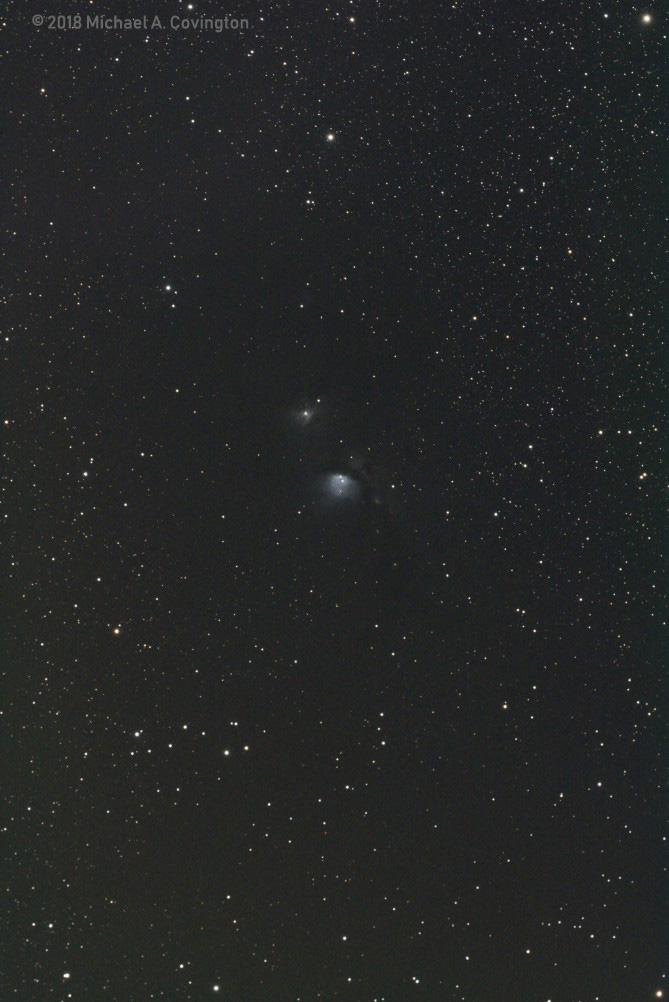
M78 is a reflection nebula illuminated by stars in Orion.
To the upper left of it is a similar, smaller object, NGC 2017,
and to the lower right, some fainter wisps.
What I want you to notice in this wide-field view is not only the two bright blobs,
but also the relative lack of stars all through the middle of the picture, compared
to the periphery.
That nebula is big and is mostly a dark nebula, a cloud of gas and dust
that hides distant stars. A few stars embedded in it illuminate their neighborhoods,
and that gives us M78 and NGC 2017.
Now zoom in on the nebulae:
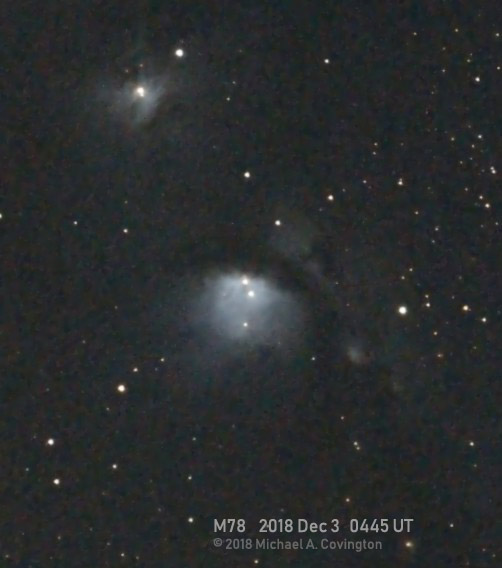
That's actually a portion of the same picture, enlarged and brightened.
Crucially, McNeil's variable nebula is not there.
It's a wisp that should be just to the right of the double star
toward the lower right.
The star that illuminates it has apparently faded.
Stack of twenty-one 1-minute exposures
(yes, twenty-one; one was a test, but all were good, so I used them)
with an AT65EDQ 6.5-cm f/6.5 refractor and Nikon D5300 at ISO 200.
Permanent link to this entry


|
2018
December
8
|
Baby, it's contentious outside...
The latest thing we're supposed to be divided about is the song "Baby, it's cold outside."
People on both sides are arguing more forcefully than the subject deserves. This isn't the clearest thing in the world, nor the most important.
Added confusion comes from the word "ban" in some headlines.
All I've really heard is that some radio stations have stopped playing it.
Can't a privately owned radio station stop playing anything it wants to stop playing?
If they hadn't said they were responding to complaints (requests), nobody would even
have noticed.
I know the song originated in the 1940s as a skit about a married couple
trying to decide whether it's time to go home from a party.
And that it was in a movie.
These things give it an official innocent interpretation.
All the early performances, and some recent ones, include a good bit of humor.
The funniest is a new one that uses video trickery to show Trump and Clinton performing it
during their debate.
But to modern ears, at least some performances of the song sound
remarkably like a seduction or date rape situation, and people find it creepy.
I know I did, the first time I heard it, long before the #MeToo movement.
It has had a surge of popularity in the past few years, and I'm sure
most of the people making it popular today don't know the history.
That, too, is creepy. Maybe they like it for the same reason I don't like it.
I am not sure the innocent interpretation was the only one even back in the 1940s. I can't
start a new career researching the song, but I wonder if there was a double interpretation
possible from the beginning (and taken, initially, as humorous).
In any case, let's not start using this song as a litmus test for whether people
are "liberal" or "conservative." Don't tell me I've been infected by
"the extremes of the #MeToo movement" or "neo-Victorian progressive prudery"
if the song makes me uneasy.
I don't like the song, and no amount of political stigma will make me like it.
But on the other hand, if someone likes the song, that doesn't mean they wholeheartedly
endorse "rape culture" either. It's a song, and it has been interpreted and
performed more than one way.
If "#MeToo" puts you off, please scroll down and keep reading.
Permanent link to this entry


|
2018
December
5
(Extra)
|
#MeToo and Christian Values
I recently had a conversation with an unfortunate fellow Christian who didn't
know what the #MeToo hashtag meant, and thought it was some kind of left-wing fad —
maybe a feminist demand for power, maybe a matter of "political correctness."
No, no, no.
The #MeToo movement is a long-overdue uprising against behavior that we Christians
have always known was wrong. For example:
(1) Man takes woman out on date, and forces her to have sexual intercourse with him, or tries to.
(2) Man takes woman out on date, and gives her a
spiked drink or drugs in order to take advantage of her sexually, or tries to.
(3) Man works with woman in office, and grabs, hugs, or kisses her when they are alone together,
against her wishes (she has shown no interest in him).
(4) Man in management position expects sexual favors from female subordinates or rewards them with job advancement.
And so on. The #MeToo hashtag means, "Somebody has done or tried to do something like that to me."
Its purpose is to raise awareness that these incidents are not rare and need to be opposed
systematically. Because they happen in secret, it's easy for the victims to imagine that they are much
less common than they really are. And perpetrators often intimidate people into
not speaking up. We must be careful not to cooperate with the intimidation.
We're not talking about misconstrued friendly gestures or momentary verbal blunders.
We're talking about things that are deliberate, offensive, and wrong.
I know that if you scour the world, you can find examples of people saying unreasonable things with a #MeToo
hashtag. But that doesn't invalidate the basic concept. I also know that most of the #MeToo movement are
not Christians and not 100% in line with our beliefs about morality, nor 100% consistent with each other.
But on the major points they have raised concern about, they are doing the right thing, and we
should support them.
The notion that #MeToo is something untrustworthy and left-wing reminds me of the bad old days (I can remember
them!) when people tried to tell me Christians were supposed to be against racial equality because
it was left-wing or socialistic.
Sadly, you can get some naive Christians to oppose anything by branding it "liberal."
I do not think God is in favor of that kind of shoddy thinking.
See also this link.
Permanent link to this entry


|
2018
December
5
|
George H. W. Bush, 1924-2018
We mourn the passing of the President who gave us the phrases
"kinder, gentler nation," "compassionate conservatism," and "a thousand
points of light."
There has never been a perfect President, and I'm sure some things could be said
in criticism of this one. But it's remarkable how he contrasts with the style in
which conservatism is practiced and advocated today.
Permanent link to this entry
Major computer museum coming to Atlanta
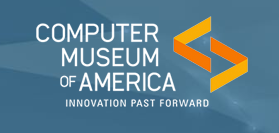
Atlanta is getting a major computer museum.
On Friday I was privileged to get a preview of
The Computer Museum of America,
which is being built in Roswell Town Center Mall near Atlanta.
The founder has been collecting computer artifacts in a big way for a long time —
not just old home computers and the like —
I found myself standing a room full of Cray supercomputers!
The plan is to make this a gathering place for computer enthusiasts around Atlanta,
with rentable meeting spaces, a snack bar, and other attractions besides just the museum
exhibits.
I wish them success — if carried out as planned, this will be the biggest computer museum
in the world.
Permanent link to this entry
Short notes
Territorial expansion of Sharonland:
When they were little, Cathy and Sharon used to pretend that their bedrooms where
principalities called Cathyland and Sharonland.
Now that Cathy has been married and out of the house for several years, her old room is
being repurposed so Sharon can have a two-room set.
It's being painted today.
Given that it's an expansion of Sharonland, I wonder if there should also be a
flag-raising ceremony or something.
In re John Chau: Whatever you think of John Chau's tragically failed attempt to
evangelize the Sentinel Islanders, you should know that
initial press reports were false in several particulars.
He was not untrained or unsponsored. If you're still following the incident,
you owe it to yourself to look at currently available information. The dust
hasn't finished settling.
Busy time:
Between my thriving consulting business, the territorial expansion of Sharonland, and
other things, I've been too busy to write Notebook entries for several days.
But now I'm back. Look for societal commentary and also astronomical photographs in
the next few days.
Permanent link to this entry


|
|
|
This is a private web page,
not hosted or sponsored by the University of Georgia.
Copyright 2018 Michael A. Covington.
Caching by search engines is permitted.
To go to the latest entry every day, bookmark
http://www.covingtoninnovations.com/michael/blog/Default.asp
and if you get the previous month, tell your browser to refresh.
Portrait at top of page by Sharon Covington.
This web site has never collected personal information
and is not affected by GDPR.
Some older pages that contain Google Ads may use cookies to manage the rotation of ads.
No personal information is collected or stored by Covington Innovations, and never has been.
This web site is based and served entirely in the United States.
In compliance with U.S. FTC guidelines,
I am glad to point out that unless explicitly
indicated, I do not receive substantial payments, free merchandise, or other remuneration
for reviewing or mentioning products on this web site.
Any remuneration valued at more than about $10 will always be mentioned here,
and in any case my writing about products and dealers is always truthful.
Reviewed
products are usually things I purchased for my own use, or occasionally items
lent to me briefly by manufacturers and described as such.
I am an Amazon Associate, and almost all of my links to Amazon.com pay me a commission
if you make a purchase. This of course does not determine which items I recommend, since
I can get a commission on anything they sell.
|
|





























